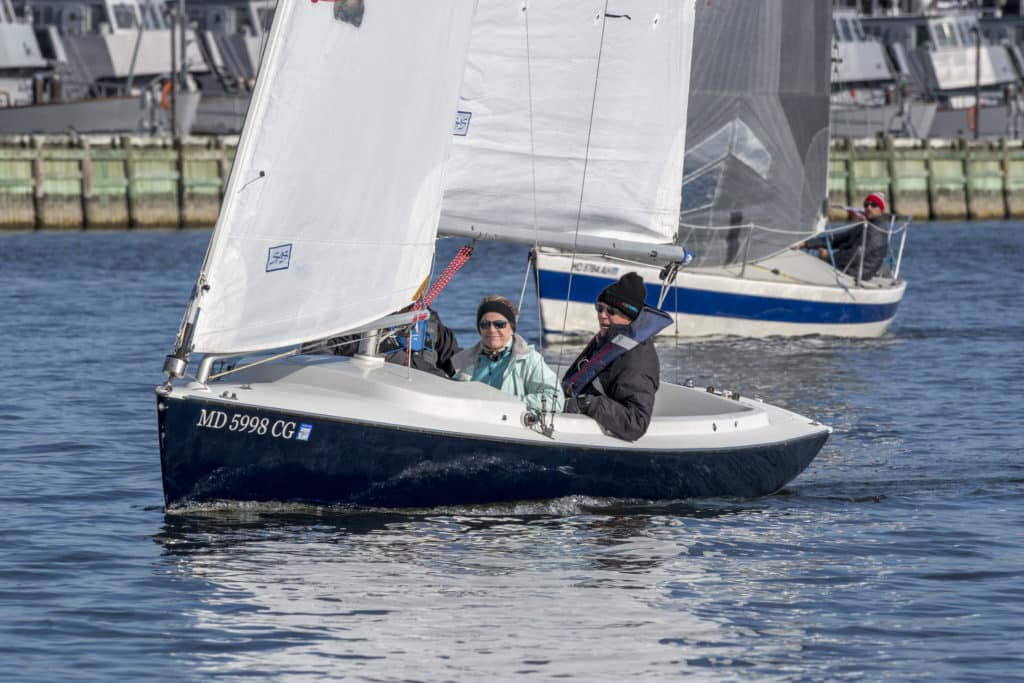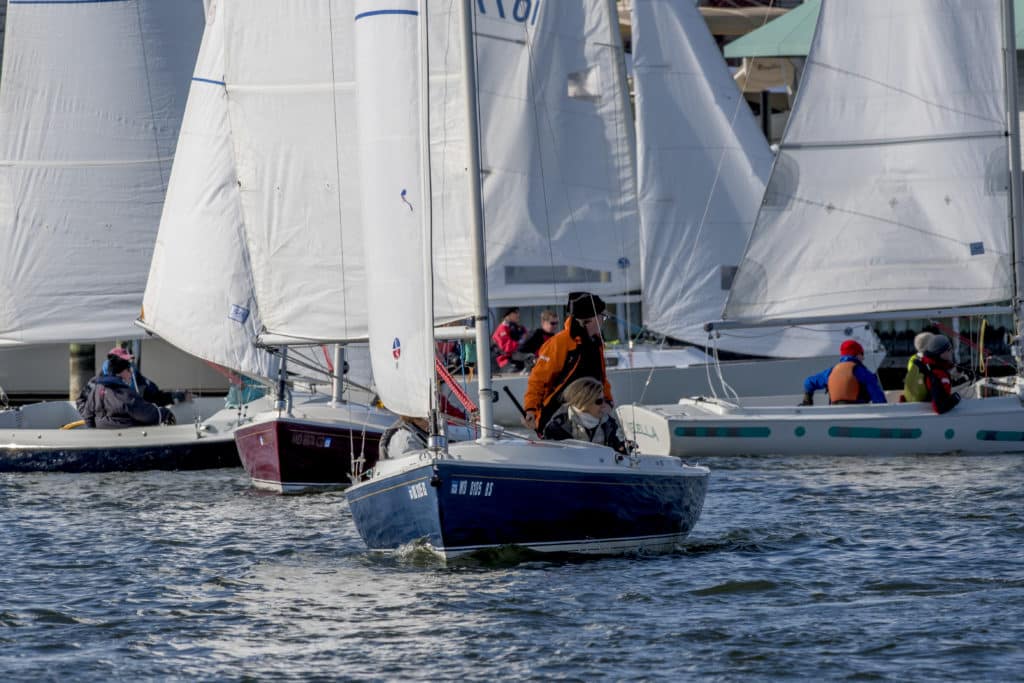
Any outdoor activity on a cold winter day is good for the soul. Frigid air sharpens the senses and rewards the enthusiast with a sense of accomplishment. While frostbite sailing sounds daunting, it is one of the great winter pleasures in cold climates. It’s the only time of year where sailing harbors provide open yet sheltered waters, empty mooring fields, and no annoying powerboat wakes. The sailors have it all to themselves.
Even ashore, everything is different. Bare trees allow wind to blow across the racecourse more naturally. The low, soft light of a winter sky illuminates boats in unique tones. It’s no accident that great photographers use this winter light during a sunrise or sunset to record their best images. The feeling I get when racing in winter is similar to a day of skiing: With the right mindset and the proper clothing, it’s an absolute joy.
Frostbiting is popular in many sailing towns around the East Coast. Any passersby would surely look sideways at a fleet of little boats out on the water dodging thin shards of ice, but little do casual spectators realize how exhilarating it is to be out sailing while everyone else is huddled indoors.
I’m reminded of this whenever I spend afternoons racing Harbor 20s off Annapolis. In our hometown fleet, about 100 boats gather off the U.S. Naval Academy seawall for two races every weekend. A couple dozen Lasers are also out on the water, each of them heeding three basic unwritten rules: safety is paramount; proper clothing is essential; and if the weather is too harsh, having the courage (and intelligence) to call it off for the day is required.
Annapolis Yacht Club’s frostbite sailing instructions state that every boat must race with at least three people, lifejackets are required, and you are not allowed out of the cockpit during racing. This is because the biggest danger is falling into the water. The idea of requiring three people to be on board is that two people have a better chance of retrieving someone who’s fallen overboard.
Hypothermia is a serious issue. I learned what really cold water feels like during a cruising expedition several years ago off Cape Horn while filming a documentary. For fun, I decided to go swimming, and my first plunge was a quick in-and-out alongside our inflatable dinghy. I was in the water only a few seconds, and it did not feel so bad. The next step was to turn the camera on and dive in. What a mistake. It felt like thousands of sharp needles piercing my skin. I lost my breath and turned white. A crew mate threw a line and hauled me back to the boat. I was shivering for the next two hours and sat next to the heater with three blankets wrapped around me. That shock gives me the chills to this day.
This past December, two-dozen Lasers were out racing in very light wind off Annapolis. A cold front slammed the fleet, and within seconds, winds ratcheted up to 50 knots. Every boat capsized. Among the racers was past college All-American sailor Dixon Smith, who is now a three-star Navy admiral. He told me the chase boats got all the sailors out of the water within two minutes. Their only concern was rescuing sailors: A few of the Lasers blew a long way out into the bay, and were eventually recovered after the front blew through. Smith said everyone had drysuits and lifejackets, and reported that everyone worked to account for each other.

If you keep your head and hands warm and your feet dry, frostbite racing is comfortable, however. Think of a chilly morning in the summer. The water is cool, and yet you want to go swimming. The usual remark after diving in is, “It’s not so bad, once you jump in.” The same philosophy applies to frostbiting. It might look miserable from the shore, but once you start racing, the competition always takes mental priority, and your mind somehow ignores the cold. The routine can be a little harder in a small dinghy like a Laser or a double-handed dinghy, but there are clever ways to keep hands and feet warm — waving one’s arms wildly to force warm core blood to your extremities is common. Disposable heat pads help too, and some sailors swear that one hot toddy before casting off will do the trick.
In winter we can see things that are difficult to judge in summer. The low light and lack of confused chop make current sheers and wind gusts more visible. One Sunday afternoon, for example, the current was flooding into the Severn River, and I noticed odd-shaped ripples along the shoreline. While most of the fleet stayed in the middle of the river on the long run to the leeward mark, we sailed toward the shoreline and found an ebbing counter-current. The extra speed propelled our boat into the lead in both races. I doubt I would have picked up such a clue on a chop-riddled summertime racecourse.
The Annapolis fleet schedules two races per day, with a break in between back on shore. Races usually last about 45 minutes. During the break, sailors swap tales while warming up with chili and hot cider alongside a roaring fireplace. It always amazes me how quickly one recovers from the cold. The mandatory break on shore is good for socializing too, of course, and for picking up tips for the afternoon race. Once back on the water, it becomes more fun when snow flurries dance over the water. It’s one of sailing’s most surreal experiences.
A frostbite fleet on Long Island Sound proudly displays a flag with a polar bear facing with his backside toward the wind. Such humor is not lost on diehard frostbite sailors. I still have a mental image of Dr. Stuart Walker racing an International 14 on a very cold New Year’s Day about 50-plus years ago. He smoked a pipe all the way around the racecourse. He continued racing a Soling all winter into his early 90s.
In the early 1960s, I crewed for a noted sailor in a frostbite series in New York. The fleet had an interesting routine. When we arrived back at the dock after the races, a group of college students were standing by to take the bowline and put the boat away. It was a nice touch that I haven’t seen since. In Annapolis, winning the second race is important so you can be among the first boats to the hoists. After the finish, it’s a full-sprint race to the dock because temperatures drop dramatically once the sun starts setting.
One frostbite experience that was over the top involves Buddy Melges, who shipped his 12 Meter to Victoria to practice with a Canadian challenger one winter. Overnight, on the third day, a snowstorm covered the city with 3 feet of snow. Buddy decided we should sail anyway. It was blowing about 20 knots, and after shoveling the snow off the deck, we hoisted the mainsail and set a spinnaker for a two-hour sail downwind. Then it was time for the upwind sail home. It took three hours. I have never been so cold. Colder, I’d say, than my Antarctic dip. The next day, we played basketball inside a gym.
Another vivid memory I have was a sail across the Drake Passage from Cape Horn to the Antarctic peninsula. The first 400 miles was a broad reach with the temperatures in the mid-40s. Once we crossed the Antarctic convergence zone where the water temperature is below freezing (the salt water keeps the water liquid), the temperature plummeted before our eyes. The watch rotated turns on deck every 30 minutes, and while we had a warm diesel heater below, I wondered how the ships of old handled the cold day in and day out. That crossing might have been the ultimate frostbite sail for me.
In winter, I keep my Hood 32 open-cockpit sloop in commission for sailing, and anytime the weather is reasonable, I’ll go for an hour sail. Every time I do, I feel totally refreshed. Like me, when frostbite racers come back to the dock, they’re always smiling. Maybe it’s because they’re keeping their skills sharp for the coming season, but I’m certain it’s the satisfaction of knowing they’ve achieved something few people appreciate: sailing when few would dare.









